Paddling the Gull River
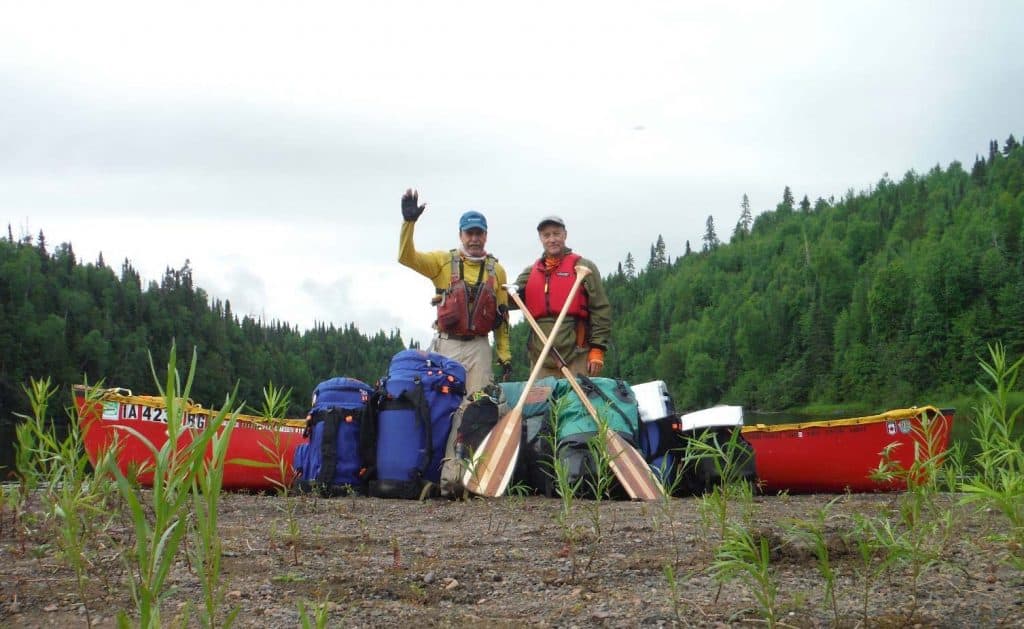
Vern Fish & Dave Fish with canoe (Iowa Rose) and gear on Sandbar Campsite, Day 5.
Gull River Canoe Trip Report
Trip Dates: July 10 – 20, 2017
Nearest City: Armstrong, Ontario
Put in: Gull River Crossing –Kitchen Lake Road, East of Highway 811 (Garden Lake Rd)
Take out: Gull River Indian Reserve (#55) – Gull Bay, Lake Nipigon
Distance: 100 km or 60 miles
Water level: Low
Boat: Spirit II by Wenonah (17” Royalex)
Outfitter: Mattice Lake Outfitters – www.walleye.ca
Paddlers: Dave Fish, Winsor Heights, Iowa, Vern Fish, Waterloo, Iowa
Difficulty: Intermediate – This trip requires expedition canoeing skills and the willingness to paddle whitewater up to CIII.
Submitted by: Vern Fish, vernfish@aol.com
Gull River
I was looking for a remote river with runnable rapids where someone could learn to run whitewater. I wanted a wild river that could be run in less than two weeks, that was not overly expensive and was relatively close to home. In 2008 I had volunteered to help clear portage trails as a member of the Wabakimi Project and fell in love with the region. I had returned several times to explore Wabakimi Provincial Park and the huge wilderness complex that surrounds it. Armstrong, Ontario is the gateway to Wabakimi region and it is located three hours north of Thunder Bay, Ontario. The only road in and out is Hwy 527 which crosses the Gull River south of town. Having seen this provincial park on the maps and having driven over it several times, I begin to research the possibility of paddling it.
Mel Baughman paddled the Gull River in 1999 and posted a trip summary at https://canoeing.com/gull-river-summary/ in 2015. Mr. Baughman ran the Gull River when it was bank full due to heavy rains. He described it as “the most arduous 5 day trip I ever completed.” He went on to stay that in his opinion, “this river should only be canoed by people in good physical condition with considerable whitewater experience.” Mel also noted that the river dropped 40 feet/mile in the first six miles and 5.5 to 9.5 feet over the next 35 miles.
Ken Kokanie ran the Gull River in 2011 and posted a video summary of the trip at http://www.myccr.com/phpbbforum/viewtopic.php?f=108&t=38778. He noted that, “This river route boasted challenging whitewater, numerous wildlife sightings, including moose, bear, eagles, turkey vultures and the normal and omnipresent contingent of Northern Ontario black flies, mosquitoes and sand flies. Campsites were virtually non-existent in the upper river and portages were difficult, if not impossible to find.”
He also echoed Mel Baughman’s comment about the difficulty of this river. He noted, “this route should be treated as remote northern wilderness, and the appropriate skills and experience are recommended. Based on our trip through the park, we would concur with this assessment, and only experienced whitewater paddlers and those with extensive wilderness camping experience should attempt this route.”
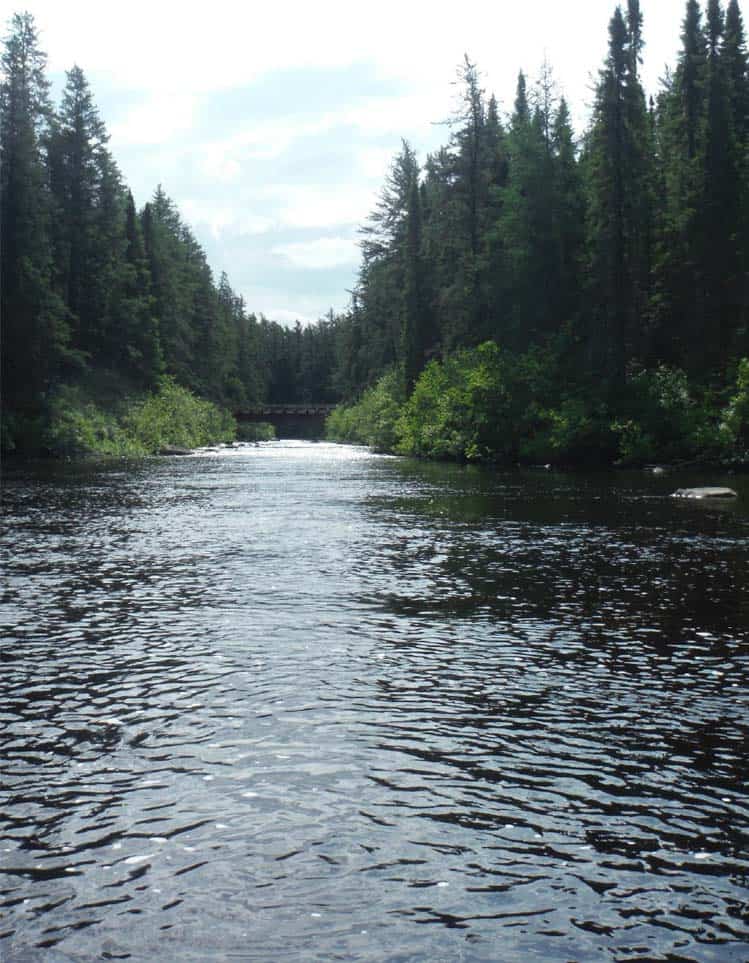
Looking up the Gull River to the Kitchen Lake Road Bridge
The Gull River also provides access to the Devil’s Crater in the Pantagruel Nature Reserve. This scenic geological formation was created over 9,000 years ago by the retreat of the Laurentide Ice Sheet. The crater features lichen-encrusted cliffs that rise more than 70 meters out of a tiny lake. However, access to the Devils Crater requires paddling up Pantagruel Creek from the confluence with the Gull River. There are no known trails, portages or campsites on the route into the crater and the trip up the creek should be considered an extreme challenge. Go to this website for more information on the Devil’s Crater: http://www.jon-nelson.com/devils-crater-portal-to-the-past.
I also found a reference to pictograph sites in Gull Bay in the Selwyn Dewdney book, Indian Rock Paintings of the Great Lakes. The description of the location was very vague and Gull Bay is a big area but it sounded like there was a chance to find a significate cultural site at the end of the trip.
The Gull River had what I wanted. It was a short remote wild river filled with wildlife and runnable whitewater. The side trip up Pantagruel Creek and the pictograph site sounded like an extra bonus.
Maps & References
The best map I found for the trip was the official provincial park map. Ken Kokanie had provided a copy of this map in his trip report. (http://kokanie.ca/files/canoeTripMaps/final_GullRiverCanoeRoute.pdf). I could not find this map anywhere else so I am assuming the map is out of print.
This map provided excellent detail about the placement of rapids and their classification. We found these details very helpful as we planned our trip and made decisions about running or portaging around rapids. The map also showed portages that have not been maintained and have been absorbed by the forest. We ran or lined all but one CIV rapids and portaged/lined around the Gull River Falls so the overgrown portages were not an issue to us. However, if you are not comfortable running CIII drops these overgrown portages would be a big issue.
This map also showed campsites that have not been used for years. Some of these campsites no longer existed while others required considerable sawing and cutting to be useable. We also found areas that were not marked on the maps that could serve as campsites with a little saw work. I have marked these sites on the map at the end of this report.
I ordered the following Canadian topographic maps from Maptown (www.maptown.com) in Calgary, Alberta:
52 H 14 Gull Bay
52 H 11 Kabitotikwia Lake
52 H 12 Holinshead Lake
I cut these maps down to a 13” X 17” so they would fit into a SealLine map case. I then transfered the details from the provincial park map and other notes from my research on to these 1:50,000 topographic maps and laminated them.
Permits & Fees
We purchased non-resident daily camping permits for Crown Land from Mattice Lake Outfitters. Non-residents can buy camping permits online (www.ontario.ca) or through participating Service Ontario Centres. The cost was $9.35 + tax (per person, per night)
Logistics
Dave Fish, my first cousin, drove from Des Moines to my house in Waterloo, Iowa on a Friday night. We then headed north the next day for a run down the Upper Iowa River east of Decorah, Iowa. This was a fundraising event for the purchase of a 1200 acre tract along the Upper Iowa River by the Iowa Natural Heritage Foundation. It delayed our departure for Ontario, but it was for a very good clause. We stopped north of the Twin Cities on Saturday night and completed the drive to Armstrong, Ontario the next day. We spent the night in a cabin provided by Mattice Lake Outfitters (www.walleye.ca.)
The next day we loaded up our canoe and gear in a Mattice Lake truck and drove south on Hwy 527 toward Thunder Bay. We crossed over the Gull River on our way to the intersection with Hwy 811. We drove northwest on Hwy 811, a gravel road, while looking for the Kitchen Lake turnoff. We found the turnoff and a troubling sign which indicated that, “use of any motorized vehicle beyond this sign to travel to Gull River Provincial Park is prohibited.”
The “official” access to the Gull River Provincial Park is where the Hwy 811 crosses the Mooseland River. The run down Mooseland River to the confluence with the Gull River is quite challenging. The narrow Mooseland River features a few unrunnable rapids that can only be bypassed by lengthy and treacherous portages. Mel Baughman had used this access and he found the rapids and the portages to be very difficult.
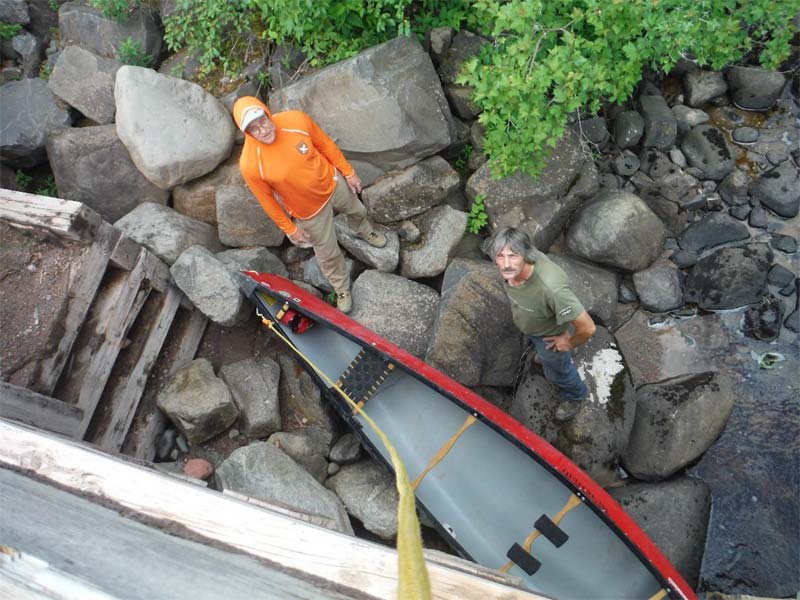
Access to Gull River off of Kitchen Lake Road bridge.
I had chosen to follow the route outlined by Ken Kokanie in his report and access the Gull River from Kitchen Lake Road. We studied the sign for a few minutes and decided to press on to the Gull River crossing. We saw our first black bear as we bounced down this logging log. We arrived at the Gull River late in the morning and proceeded to “line” our gear off the bridge down to the rocky river bank. The attached photo shows how steep the drop was from the bridge to the water.
The plan was to paddle down to Gull Bay on Lake Nipigon where a driver from Mattice Lake Outfitters would pick us up at a boat ramp in the Gull Bay First Nation village (Kiashke Zaaging Anishinaabek) on July 20th. We were using a SPOT device to mark our location and Mattice Lake Outfitters were receiving these GPS updates. It is about a 25 mile drive from Armstrong to Gull Bay.
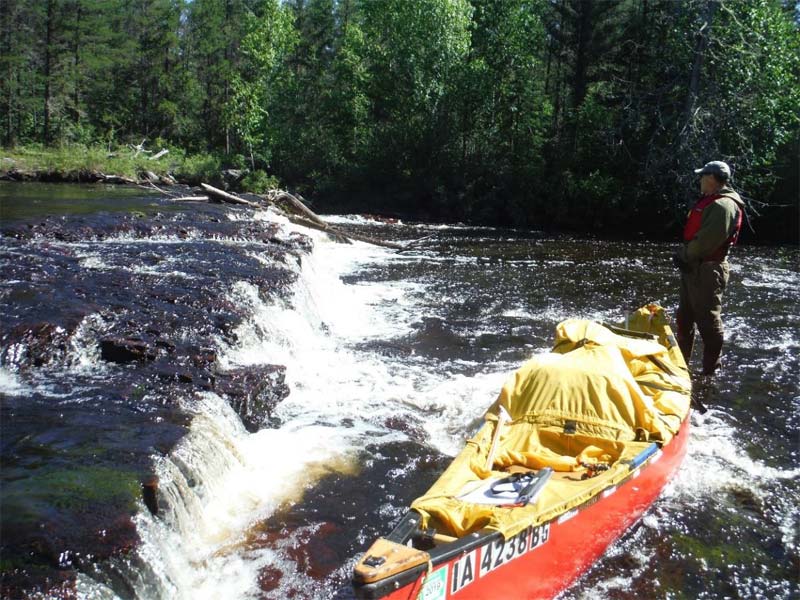
Lining over ledge into Pantagruel Lake.
Overview
Day 1 Confluence with Mooseland River (Map* 1 – F)
Day 2 Confluence with Roaring River (Map 3 – A)
Day 3 Layover day at Roaring River campsite (Map 3 – A)
Day 4 Island Campsite (Map 3 – D)
Day 5 Sandbar Campsite (Map 4 – C)
Day 6 Jack Pine Bluff (Map 4 – D)
Day 7 Pantagruel Creek Campsite (Map 4 – E)
Day 8 Gull River Falls/Detour Lake (Map 5 – C)
Day 9 KOA Campsite (Map 5 – D)
Day 10 Hwy 527 Campsite (Map 6 – A)
*These locations are marked on maps provided at the end of this report.
Over the course of ten days we would paddle about 48 miles on the Gull (Gayaashk^) River, 12 miles up and down Pantagruel Creek and another 3+ miles along shore of Gull (Kaiashk^) Bay on Lake Nipigon. We would run 34 whitewater features if each drop was counted. There were 16 Class I’s, 14 Class II’s and 2 Class III’s. We portaged around one Class IV. We also portaged around the Gull River Falls and lined around a Class III ledge below the Gull River Falls.
We saw one wolf, two swans, six moose, several pelicans, and dozens of gulls and cormorants. We barely missed hitting three bears on the roads going to and from. We caught enough walleye for two meals and lost one camera on the last rapids. We saw one legible pictograph and found several others that were badly faded or covered with spray paint. We did not get to the Devil’s Crater but we did find and mark a couple of campsites that were not on our maps.
Highlights & Observations
I would echo Ken Kokanie assessment this route should be treated as remote northern wilderness adventure. There was very little evidence that anyone had paddled or camped along this river in the recent past. We only found two portages that had been cleared and traveled recently. The only road access was a logging road into Detour Lake which provided access to the Gull River Falls. This same road provided vehicle access to one campsite located downstream from the falls. I called it the “KOA campsite” because it had a fire pit, crude tables and open grassy camping pads. It was the only campsite that was clearly being used.
The majority of the whitewater was concentrated in the upper half of the river. Since the bulk of the portages had been overwhelmed by the forest we had little choice but to run all but a couple of the rapids. However, almost all of these rapids were non-technical, runnable drops. The Gull River is a great river to practice and learn how to run whitewater. The river is also filled with wildlife which meant we never knew what to expect around each bend. More than once we ran a small rapid and came face to face with a moose standing in the eddy at the bottom of the drop. The upper river is also flanked by several large bluffs/hills that would have been fun to climb, just to enjoy the view.
Ledge on Pantagruel Creek
For a variety of reasons we did not start our run up Pantagruel Creek to the Devils Crater until noon. The literature was right about the trek being an “extreme challenge.” Trying to drag a loaded canoe up that little creek was backbreaking. We finally unloaded the gear and tried to drag the canoe over the rocks and log jams until we ran out of daylight and were forced to turn back. What makes this side trip really hard is that we did not find a single place where we could camp along the route. Thus, we were forced to make the round trip of about 12+ miles in day. We did find a campsite just below the first rapids out of Pantagruel Lake which would make a great place to start the trek. I would like to go back and finish this side trip.
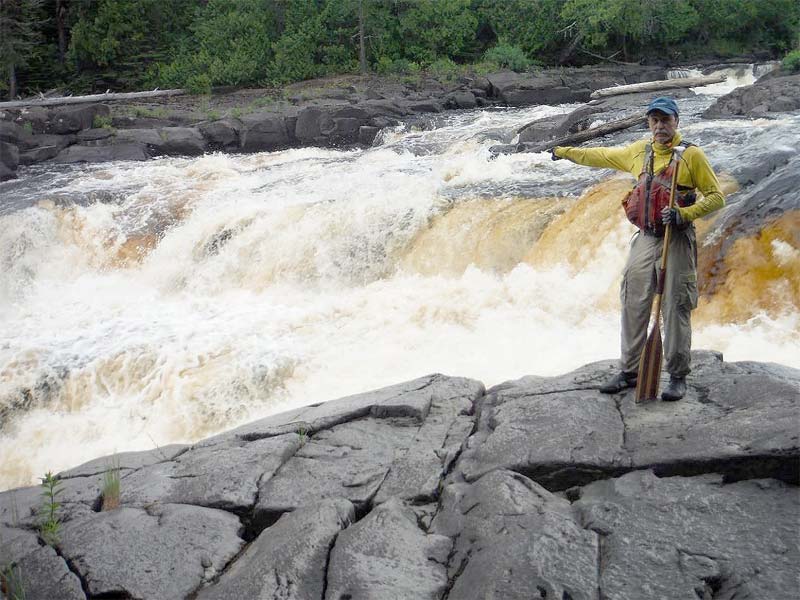
Vern Fish standing beside Gull River Falls.
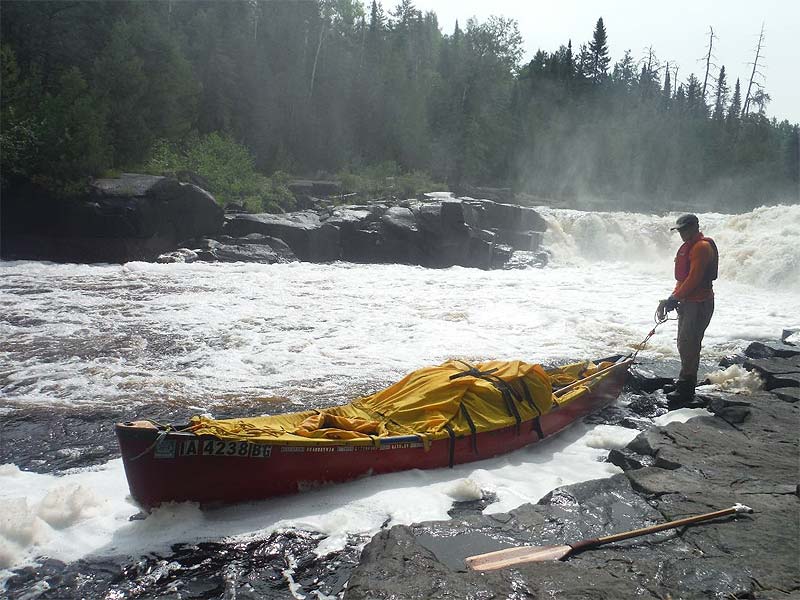
Dave Fish lining just below Gull River Falls.
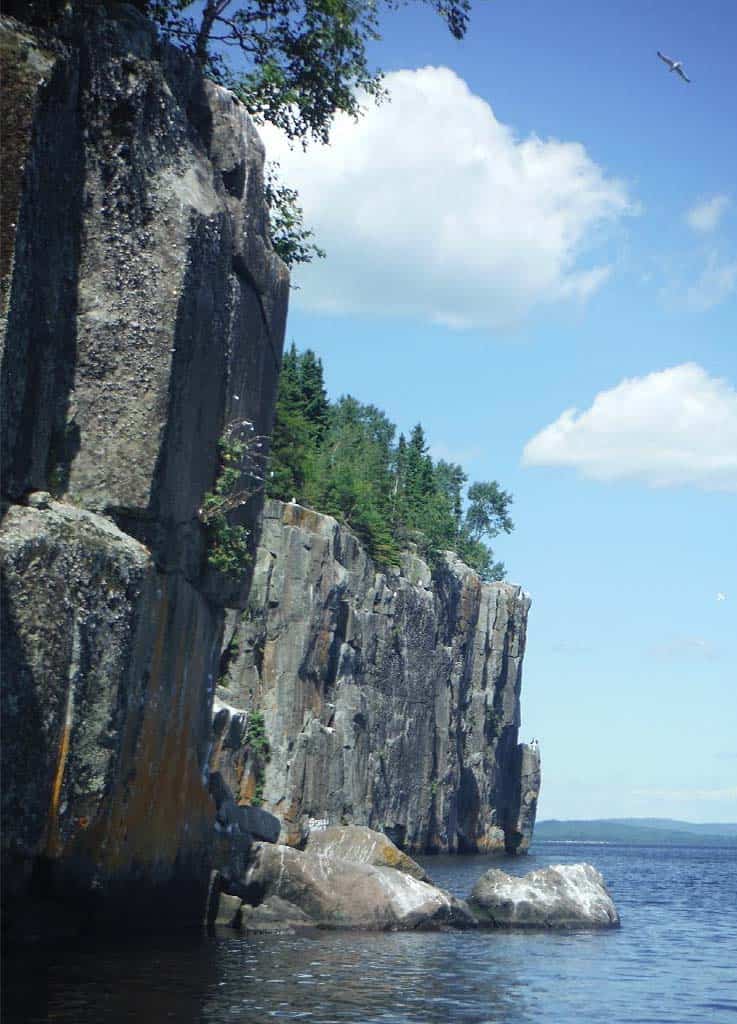
Line of cliffs south of Gull Bay
The Gull River Falls was both impressive and frightening. The run starts with a CII and then the river turns to the right as the flow forced us over a small ledge on the left. The falls was completely shielded from view by a huge rock ledge as we picked our way through a boulder field. We eddied up at the ledge thinking it was good campsite and were totally shocked when we walked over to the other side and saw the falls. It would be very easy to paddle over the falls. Mel Baughman was downstream looking upstream when he estimated that the falls had a ten foot drop. We spent a night on the ledge overlooking the falls and ten foot is good guess. Nobody in Armstrong could tell me if this falls has a name.
The last 20 miles or so the river meandered back and forth and in and out of old oxbows and wetlands. We saw the swans and a lot of waterfowl in these wetlands, but saw very few places to camp. Occasionally the river would cut into a glacial ridge and expose a layer of sand and gravel. The scenery along the lower river was picturesque but repetitive. The wetland complex in Gull Bay was big and impressive. We literally had pelicans trying to land in the canoe while gulls were flying above screaming and diving. As we traversed Gull Bay, we could look out and see that Lake Nipigon was a big, imposing body of water that was too vast to explore in 17 foot canoe.
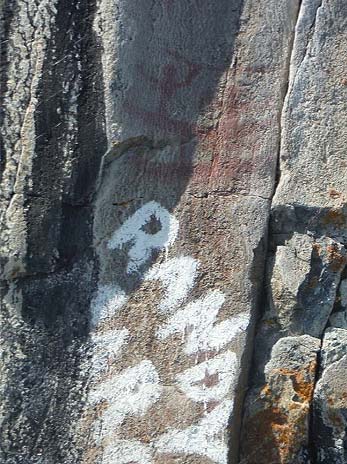
Pictograph and graffiti on cliffs south of Gull Bay.
Paddling on Gull Bay, Cousin Dave, saw an impressive line of cliffs south of the village. Selwyn Dewdney described a four mile line of cliffs south of Gull^ (or Kaiashk) Bay where he found pictographs in 1959. I was confident that we might find pictographs on these rocks so we paddled across the big bay. It was satisfying to find one of the images that Mr. Dewdney documented on our last day. However, it was disappointing and disturbing to find graffiti spray painted on these distinctive cliffs and over some of the pictograph images.
^The river’s name is translated from the Ojibwa name, Gayaashk. Selwyn Dewdney refers to Gull Bay as Kaiashk Bay on page 77 of his book Indian Rock Paintings of the Great Lakes
Gull River Trip Log
July 10 – 20, 2017
Overview*
Day 1 Confluence with Mooseland River (Map 1 – F)
Day 2 Confluence with Roaring River (Map 3 – A)
Day 3 Layover day at Roaring River campsite (Map 3 – A)
Day 4 Island Campsite (Map 3 – D)
Day 5 Sandbar Campsite (Map 4 – C)
Day 6 Jack Pine Bluff (Map 4 – D)
Day 7 Pantagruel Creek Campsite (Map 4 – E)
Day 8 Gull River Falls/Detour Lake (Map 5 – C)
Day 9 KOA Campsite (Map 5 – D)
Day 10 Hwy 527 Campsite (Map 6 – A)
*These locations are marked on maps provided at the end of this report
Day 1 – July 10, 2017
Early in the morning we loaded our canoe and gear into a Matttice Lake Outfitters truck and headed down Hwy 527 toward the intersection with Hwy 811 (Garden Lake Road). We turned north on Hwy 811 and drove up a well maintained gravel road. We started looking for the Kitchen Lake Road at every intersection until we found a faded wooden sign that said “Kitchen –Penny”. On the south side of the intersection we found a second sign with a troubling message, “use of any motorized vehicle beyond this sign to travel to Gull River Provincial Park is prohibited.”
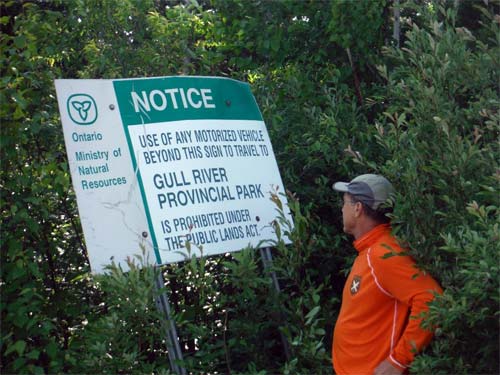
Sign at intersection of Hwy 811 and Kitchen Lake Road.
We studied the sign for a few minutes and decided to press on to the Gull River crossing. We saw our first black bear as we bounced down this logging log. We arrived at the Gull River late in the morning and proceeded to “line” our gear off the bridge and down to a rocky river bank. By noon we had the canoe loaded and on the water. We proceeded to run, bounce and line the canoe down a short 2.5 km segment on the Gull River to the confluence with the Mooseland River.
We reached the confluence and found the campsite indicated on our maps. It was a little overgrown but it did not take long to open up the space for our tents. Looking upstream we could see a class I rapid that marked the confluence with the Mooseland River. The water level was low but the additional water flowing into the Gull River was sufficient to paddle. It appears that the Mooseland River is actually as big or bigger then the Gull River. I wondered why the combined river was called Gull and not Mooseland. The larger river usually keeps its name at a confluence.
Day 2 – July 11, 2017
We got up by 8 AM and got on the water by 10:45. The first run was a CIII/IV (Map 2 – B). We walked the portage on river right and eyed the series of drops that were included in this rapid. The gorge was tight, rocky and all of the water flowed over one narrow ledge about halfway down the run. There were very few places to eddy out and lining would have difficult if not dangerous. I am sure there are people who can successfully make this run. However, for me it was too early in the trip to start running technical CIV’s.
We dug out the saws and started clearing the trail for the 253 meter portage. The trail was not in bad shape and we cleared the route fairly quickly. The walk upstream to get the last load was magical. The roar of water dropping over ledges and flowing white in the wilderness is why I picked this route.
We loaded the canoe and were immediately faced with our next whitewater run (Map 2- C). The top of the run was a CII that transitioned into a series of CI’s around the next bend. From the top, we could see where the CII started but we could not see the last CI. It looked like a continuous CII all the way to the bend in the river. A 235 meter portage cut across the inside curve of the river so we could not see the whole run without doing a lot of bushwacking.
Previous trip reports indicated that this rapid was runnable. Dave was in the stern and was ready to pilot his first CII run. The CII was a pretty good drop and we took some water. The rapid leveled out as we rounded the curve and dropped into the almost half mile chain of CI’s. The grip on my paddle began to fail as we paddled into the eddy pool at the end. I dug out some duct tape and lashed the t-grip back on to the shaft. The duct tape held for the next 9 days and 30+ rapids! We saw our first moose, a young bull, as we paddled down to the confluence with the Roaring Rapids River. Roaring Rapids River is loud! The river makes a grand entrance as it rumbles down a rocky drop into a pool where the two rivers join. We found the campsite on a low bluff overlooking the pool. The site was marked with a big blaze on a tree and was broken into two open areas. We set up the yellow dinning fly/bug tent on bushy a bluff and set up the tents in the open area back in the woods. Neither site had seen a lot of recent use. It took some time with the hand saws to clear out enough room for the dinning fly. Our solo tents squeezed into the woods with less cutting.
Before we get could get out the fishing gear, it began to sprinkle and rain. We set up the stove and cooked our supper while suffering from an onslaught of tiny sandflies/no see-ums. They were inside the bug net of the dinning fly and they made supper miserable. We both were forced to wear our bug shirts inside the bug tent just to eat!
Day 3 – July 12, 2017
The next morning we awoke to alternating waves of light and heavy rain as a series of squall lines blew through. We were trapped in the tents so we ate breakfast, napped and caught up on our journals. The rain abated by early afternoon so we finally got out the fishing gear and paddled out into the pool in front of us.
The provincial map had indicated that this location had fishing opportunities and we did catch enough walleyes for a fish supper. As we were fishing, I watched a wolf emerge from the forest and wander down to the water’s edge. He was busy swathing flies, which allowed us to paddle up fairly close. At first, he seemed more curious than fearful, but when we got close he dove back into the forest. As he left, we paddled into a cow moose who also allowed us to get fairly close. After spending most of day napping in the tents, catching walleye, seeing a wolf and a moose, was a nice way to end the day!
Day 4 – July 13, 2017
We were up by 8ish and on the water by 9:45 AM. The sun was trying to break through as we packed our wet gear. We left the roar of the Roaring River and headed downstream. The first little run was a nice CI (Map 3 – B). The second drop was listed as a CI/CII (Map 3 – C). We did not bother to see if either rapid actually had a portage but I am guessing that only moose walk those shore lines.
We found the island campsite just a short distance from the last rapid. We found a campfire ring but no one had camped on this island in many years. We cleared enough space to set up our tents and settled in for the night. It is always fun to camp on an island and this one offered a great view of the river.
Day 5 – July 14, 2017
We got on the water at 10ish with Dave in the stern on a warm sunny day. Almost immediately we were into the next rapid (Map 3 – D). It is listed as a CI but, we plowed through a pretty good wave train at the bottom. There was a long stretch of flat water until the next CII but we were not bored. A young bull moose was surprised by our appearance and in his panic he kept swimming back and forth in front us, making it almost impossible to pass him.
The next drop (Map 3 – E) was a strong CII. Again, we did not stop to inspect the 240 meter portage on river left. After a short paddle downstream, we ran into a series of drops that were one of the highlights of the trip. Actually, it could be considered just one really long drop that ended with an impressive CIII (Map 4 – B). It lead off with two CI’s that dumped into a strong CII. The CII ends in pool just upstream from a long CIII. The turn before the CIII is marked with large hanging boulder on river left. Just when it started to look easy, the run got deadly serious.
The CIII was a long line of big standing waves as it disappeared around a turn to the right.
We knew the CIII was big, long and possibly ugly, so we eddied out at the top and tried to find the portage. All we found was an animal trail on river right which ran parallel to the rapid. Portaging would have required a lot of saw work and walking over rough ground. We looked at the idea of lining and running the boat between eddies. The low water level meant that the shore-line was a boulder field that would have been really hard and dangerous to walk and line.
Other paddlers had reported that they had successfully made the run. They also reported that they took a lot of water. We had a spray skirt so I was not overly worried about swamping the canoe. I was worried about rolling the boat and possibly pinning it against a rock. We were a long way from the nearest road and help. If we made a mistake, we would pay the price. We spent a lot of time walking the shore studying a possible portage, while trying to find the best possible line of attack.
To be very honest, this run scared me. It was long, curvy and featured big standing waves. It was impossible to see a clear line for the entire run from the shore. A little voice in the back of my head keep saying, “be safe, portage and live to run another day”. I was just about to pull out my saw and start clearing trail when Dave said, “let’s run it”. I guess he got tired of the “what if’s” and was ready for action.
Keep in mind that Dave had only been running whitewater for five days. However, he had done a good job reading the water and he was really strong and athletic. Portaging would have been tough. Lining would have been dangerous or impossible. We thought we saw a line to run at the bottom of the CIII. It was a warm, sunny day, and we had plenty of daylight to recover and dry out. There was also supposed to be a campsite at the bottom of the run where we could end the day. Of the three choices, running was the most acceptable (as long as both paddlers agreed). With Dave’s input, I felt it was a good risk to take.
It was pretty much a continuous wave trail down to the bottom. Several standing waves broke over the bow. At least twice the canoe bounced off rocks or waves and the boat took some serious tips to both the left and the right. We rolled over numerous rocks and side-swiped several others. By the time we cleared the last little ledge, the boat was heavy with water. My ankles were in the water and the spray skirt had a lot of water trapped in its pockets. With that much water sloshing back and forth the boat was very tippy. We got to the shore without rolling and began the process of celebrating and bailing!
I had positioned one onboard camera to look back toward the stern. I had attached a second camera to my hat to look forward. Looking at the footage from both cameras when I got home, was both exciting and just a little scary. It seemed like we were in the whitewater forever but, the camera timer said it was just under 3 minutes. That was a long three minutes! We ran one more CI and started looking for the campsite on Map 4 – C. We went around an island at least twice and we both walked the shore line but we could not find the campsite shown on the map. We did find a flat, dry sandbar and tried to set up camp in the wind. It was a great place to wash, swim and dry out but an awfully hot place to camp.
Day 6 – July 15, 2017
We left our sandbar campsite and looked for the “Lost Campsite” one more time with no luck. We did find a blaze on a tree around the next bend, but no campsite nor the long portage that was shown on Map 4 – C.
This stretch of the river had no rapids. It meandered and wove between oxbows and wetlands. We checked out the “marginal” campsites marked on our maps and found them to be useful. They were sandbars on the inside of the curves that provided an open, sandy place to camp. They were not flat and would be emergency sites at best.
We got to rapids at Map 4 – D but could not find the campsite or the portage on river right that was marked on the map. It was getting late and we needed a place to camp. Our maps did not show any campsites between this rapid and the entrance to Pantagruel Creek. In fact, our maps did not show any campsites along the entire length of Pantagruel Creek. I had planned to paddle up Pantagruel Creek to get to the Devils Crater (http://www.jon-nelson.com/devils-crater-portal-to-the-past). I felt that we would need all day to cover this 12 mile round trip and it was already late afternoon.
We had passed a jackpine bluff on river right just before we got to the start of the rapids. We paddled upstream and found a place to climb the bluff. There was enough flat open ground under the pines for our tents and we settled in for the night. It was difficult to fish from the bluff, so I wondered around under the pines. I found a pile of old rusty cans which meant we were not the first people to camp on this bluff.
Day 7 – July 16, 2017
We have been switching seats every day, so it was Dave’s turn in the stern. Yesterday, I got to paddle the calm stretch of river with no rapids. Today, Dave got to run a wild set of four CI/CII’s (Map 4 – D). Lots of standing waves breaking over the bow and a couple of hard tilts to the left and the right. I should have had the two cameras pointing back and forward on this run!
On the way to the confluence with Pantagruel Creek, we passed an island that could have been used for camping. I have marked this potential campsite on Map 4 – E. If I had known this site was available, I would have run the rapid the night before and had been that much closer to Pantagruel Creek when we started our ascent.
We paddled into Pantagruel Creek, pulled over two ledges and a long set of rocky drops to a small pool that was downstream from Pantagruel Lake. On river right was an open area with a small fire ring and a couple open places for camping. We opened up the lunch barrel and discussed what to do next. It was already noon. It was at least a 12 mile round trip to the Devil’s Crater. We agreed that by 4:30 we needed to stop and return to the lunch site to camp.
The last ledge into Pantagruel Lake was picturesque on the bright sunny day but it was a real chore to pull a boat over it. We paddled across Pantagruel Lake and into the Ottertooth Conservation Reserve. The creek flows into the lake at the west end and we continued upstream against a sluggish current. At first, it was fairly wide, except for the occasional log jam and beaver dam. The stream opened into a wide wetland that lead to our first “rock ladder”. We dragged the canoe and our gear up this rugged rock slide until we reached a second wetland which lead to anther “rock ladder”.
The lack of water and the size of the rocks forced us to unload the canoe about halfway up the second rock ladder. With the empty canoe, we managed to get to the next wetland and on to the third rock ladder. With time running out, we left the canoe and rock-hopped up to the next small lake. It was now about 4:30 and there was no end in sight. We had not passed any potential campsites and neither one of us wanted to sleep in the canoe. We reluctantly turned around and repeated our journey back to our lunch site.
The bad news is that we barely got back in time to set up camp and eat. The good news is we saw another moose on way back. The trip up Pantagruel Creek requires a full day and an empty canoe. Devil’s Crater will have to wait for another year because Pantagruel Creek kicked our butts!
Day 8 – July 17, 2017
We ran into another moose as we paddled out of Pantagruel Creek and back into the Gull River. Almost immediately, we ran a nice set of six CI’s (Map 5 – A) which was followed by another short series of CI’s (Map 5 – B). The maps shows a couple of potential campsites which we could not find. However, we did find a culvert that had been washed down a side creek from the logging road which runs parallel to Gull River.
It was a long charming float down to the Gull River Falls after clearing the CI’s. There were big hills/mountains on both river right and left. I wish we had taken the time to stop and climb one of peaks, just to enjoy the view, before taking on the Gull River Falls!
The approach into the Gull River Falls was both technical and complicated. The sequence began with a CII followed by a campsite on river left. Almost immediately another CII had be negotiated before exiting on river right to avoid the falls. The map shows a long portage on river right that begins before the first CII. Downstream from the Falls, the map shows another falls followed by another CII separate by three islands. Ken Kokanie had reported seeing a ledge downstream from the falls that he thought could be lined. Mel Baughman portaged around the entire complex of whitewater by using the logging road on river left. Ken Kokanie portaged around the falls by following a trail on river left.
Thus, the Gull River Falls was a bit of mystery and a source of both anticipation and anxiety. Dave was in the stern and I did not even bother to ask him to pull over and look for the portage on river right. I knew there was a logging road on the left and I seriously doubted that we would actually find a maintained portage trail.
We went into the first CII with the idea that we would eddy out on river left and look for a campsite. Immediately after clearing the CII, we were forced by the flow over a little ledge and into a boulder garden. There was really no place to eddy out so we tried to stay as close to shore on river left as possible. I saw a small pool in front of a big slab of rock on the left and I yelled at Dave to pull in and eddy out. We were surrounded by whitewater on all sides and the roar of falling water was deafening and overwhelming. I knew there was a falls coming up but I could not see nor hear the drop.
We both caught our breath and climbed out of the boat to see just where we had landed. I climbed over the big rock slab and stared down the ten foot drop of the Gull River Falls! We had come within 20 feet of going over the falls! I wish I had a photo of Dave’s face when I lead him over to the falls.
After pitching our tents on the rock slab, we explored the falls, the trail on river left and walked up to the logging road. It was obvious that people had been using ATV’s to access the falls from the logging road. We found our first garbage on the trip. How to get around the falls would be the problem to solve the next day. It was time to enjoy the roar, rumble and spray from the big drop.
Day 9 – July 18, 2017
It was warm and sunny as we packed our gear for the hike up to the logging road. My initial thought was to follow Mel Baughman’s lead and use the logging road to by-pass the falls. While I waited for Dave to finish packing, I continued to explore the “goat trail” along the left side of the river. I could not image how Ken Kokanie got his gear down this trail. I also could not image hauling our gear up to the logging road and then back down to the river. Mel had talked about using ropes to lower the canoes to the water.
Ken’s report mentioned the idea of lining the ledge below the falls instead of portaging. The map showed a second falls but it is really just a nasty irregular ledge. The more I looked at our options, the more I liked the idea taking a short portage around the falls and lining our way down river until we were past the ugly ledge. It did not take long to convince Dave that lining would be more fun than taking a really long portage on a road.
The portage around the falls was quick and fairly easy. Lining along a vertical rock face and the rock garden (downstream from the falls), was another set of problems. Working together and trying to stay safe, we managed to pass the ropes up, over and under rocks and trees to slowly move the boat and the gear downstream. A couple of times we got in and ran short segments before we were forced to eddy out. We got down to the ledge and lined the boat around the drop. By then, it was noon and time to stop for lunch.
We now had to maneuver the boat into a CII rapids below the ledge. The river curved to the right so we could not see the line before we entered the rapid. At that point, we were both so tired of dragging the boat down the side of the river that we enjoyed the challenge of entering a CII sideways and running a series of tricky drops sight unseen. The first CII was followed by a two more CI/II’s in rapid succession. After over 4 hours of exploring, portaging, lining and running whitewater we had gone about a mile!
The next task was to find the (good) campsite downstream from the last CI/II. If we missed this campsite, there were no more campsites until we reached the Hwy 527 bridge (which was long way downstream). The map showed it on the outside bend of next right turn of the river. Hugging the left shore we drifted downstream searching for a place to camp. It was not hard to see the table, the rope ladder up the bank and rocks piled up for a fire ring from a distance. This was a well-established campsite with crude tables and ropes strung out for cloth lines. I called it the “KOA” campsite because it had all of the modern amenities. After setting up camp we loaded our fishing gear and drifted downstream to the “fishing opportunity” site marked on our map. After a few passes we found the sweet spot at the next bend in the river and proceeded to catch walleyes for a fish supper!
Day 10 – July 19, 2017
We loaded up and left our great campsite on a warm and sunny day. The only CI of the day flowed beneath our boat before we entered an endless series of meanders, oxbows and wetlands. A pair of swans got in front of us and refused to let us pass. We “chased” them for several miles. Occasionally the river would cut into a glacial ridge and expose a layer of sand and gravel. The scenery along the lower river was picturesque, but repetitive.
We started to see a few cabins, campsites and crude boat ramps. It was impossible to say if we had entered the Gull River Indian Reservation until we started to hear traffic noise. Finally, the 527 bridge came into view. The access beneath the bridge was a mess. There was just too much garbage to camp under the bridge. We paddled upstream until we found a little bluff where we created enough space in the bush to set up camp. We could still hear the trucks but it was a clean space.
Day 11 – July 20, 2017
The last day on the Gull River was memorable. The CI/II drop under the Hwy 527 bridge proved to be technical and we got hung up and spun around. After all of those successful whitewater runs, we screwed up the next to last drop. The last run was the biggest surprise. The map showed another rapid about halfway between the bridge and the bay but it did not list the class. There was very little current as we approached but the roar of the rapids told us it was big drop. I got in a hurry to mount my action camera and I dropped it into the water. After failing to find the camera in the fast flowing water, we proceeded to run a two part twisting CII/III with good size standing waves. Losing a camera was a painful but getting to make one more whitewater run was an unanticipated surprise.
The wetland complex in Gull Bay was big and impressive. We literally had pelicans trying to land in the canoe while gulls and cormorants were flying above screaming and diving. As we traversed Gull Bay we could look out and see that Lake Nipigon was a big, imposing body of water that was too vast to explore in 17 foot canoe. As we entered the bay, Dave saw a line of cliffs to the south of the village. Selwyn Dewdney described a four mile line of cliffs just south of Gull (Kaiashk) Bay where he found pictographs in 1959. I was confident that we might find pictographs on these rocks, so we continued to paddle south across the big bay. It was satisfying to find one of the images that Mr. Dewdney documented on our last day. However, it was disappointing and disturbing to find graffiti spray painted on these distinctive cliffs and over some of the pictograph images.
After finding the pictographs, it was time to head home. Mattice Lake Outfitters had been following our SPOT reports, they knew that we had entered Gull Bay. Their truck was waiting for us when we got back to the village boat ramp. After a short ride up HWY 527, we took a shower and enjoyed our first sit down meal in over a week. It is always a mixed blessing when one returns to civilization. However, in this case, it had been a great trip and I was ready to start planning the next great adventure!
Trip Planning
If you are planning a trip into the Wabakimi region, I would recommend that you start by calling Mattice Lake Outfitters. They offer a variety of services which includes selling fishing licenses and Crown Land permits. The two cabins they operate at Mattice Lake serve as a great place to start and end a trip. They also maintain a variety of remote outpost cabins scattered across the Wabakimi region. Their fleet of red planes can drop off or pick up just about anywhere. Flying in a small De Havilland Beaver with your canoe (tied to a pontoon) is a paddlers dream. They can also pick up by truck if the trips ends on a road.
GULL RIVER CANOE TRIP MAPS
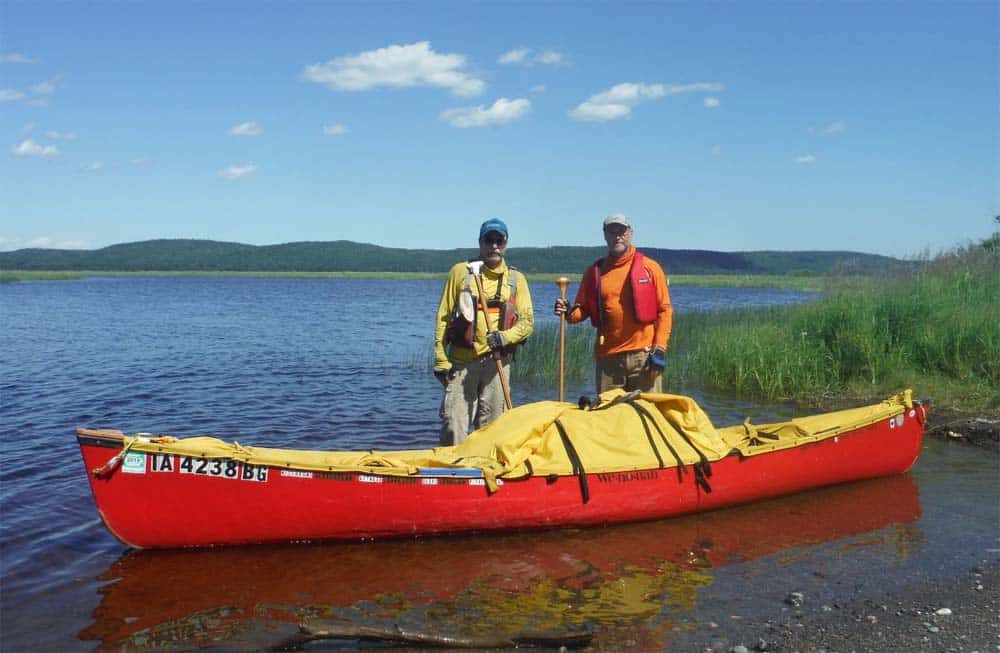
Vern Fish & Dave Fish on Gull Bay at the end of the trip.



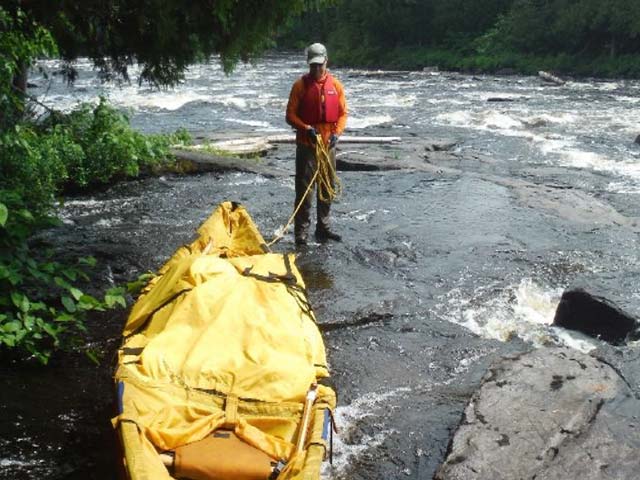
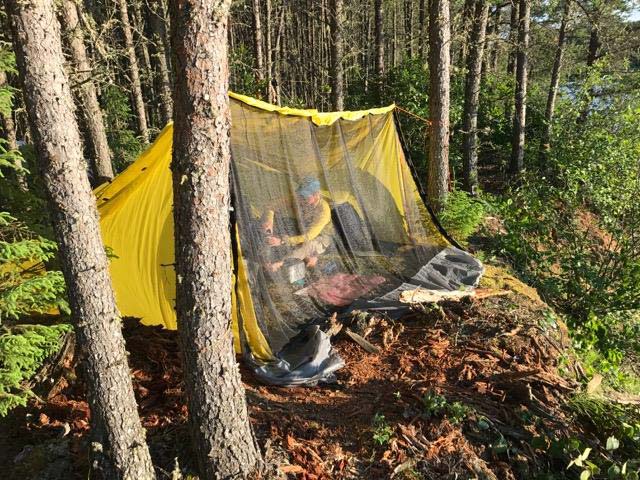
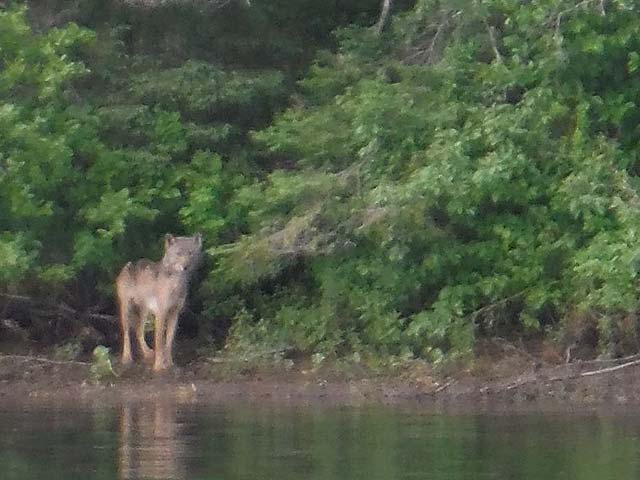
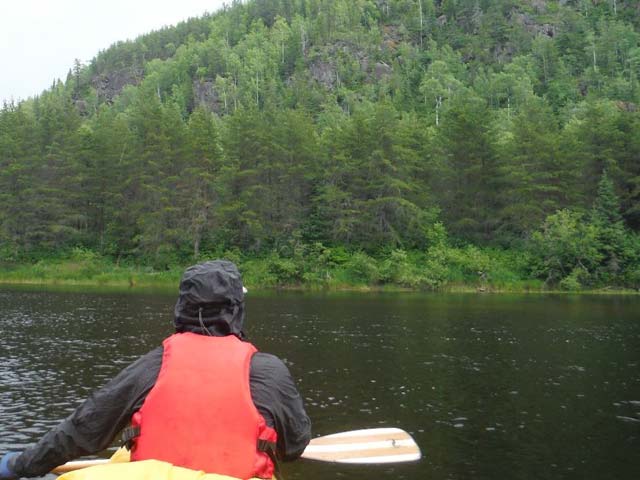
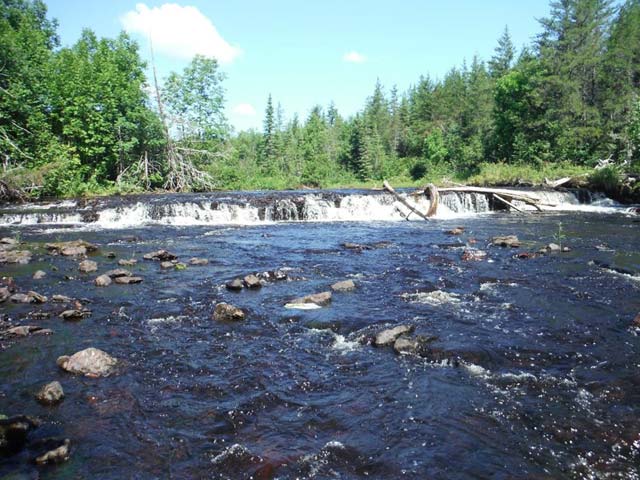
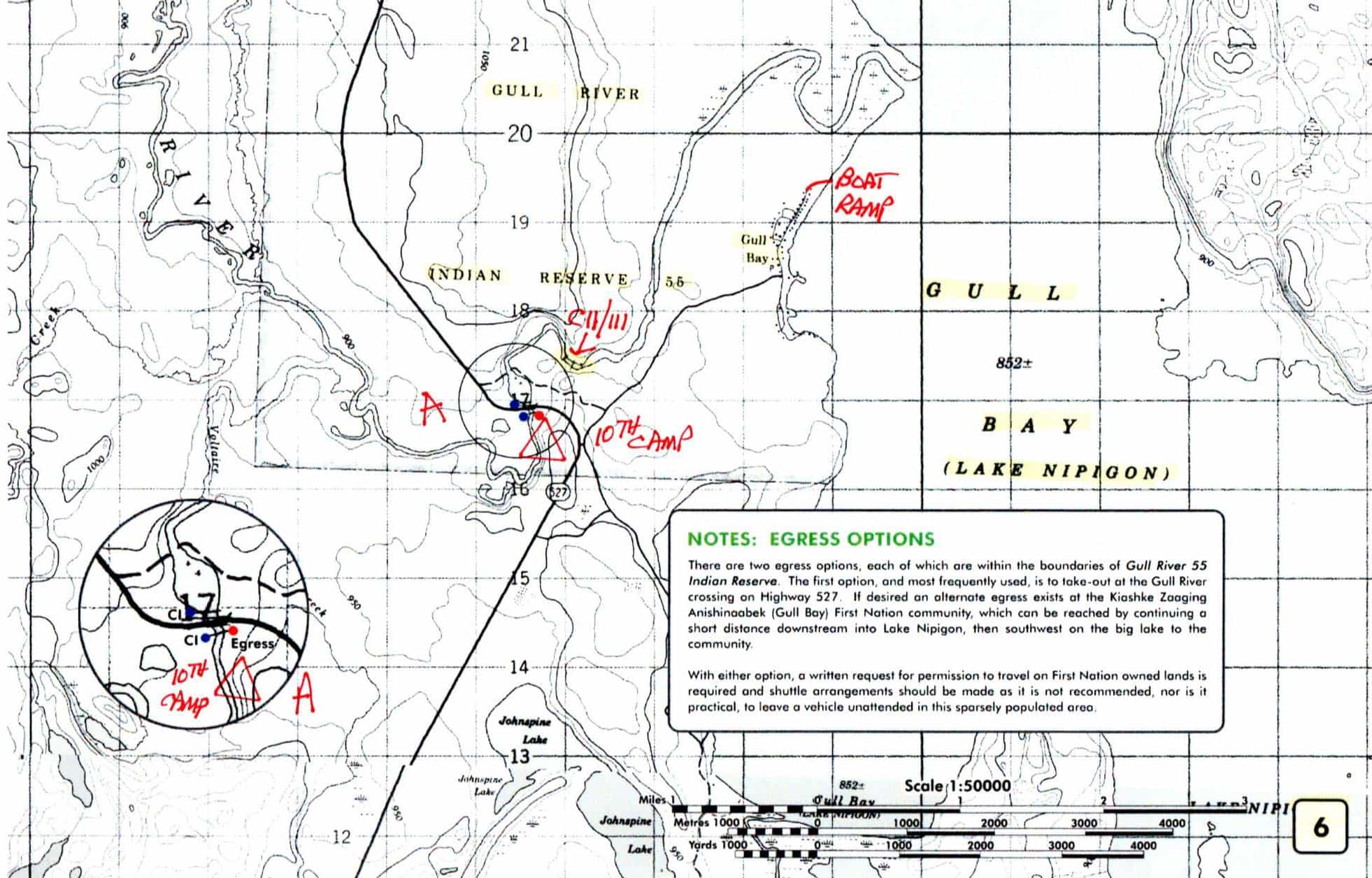
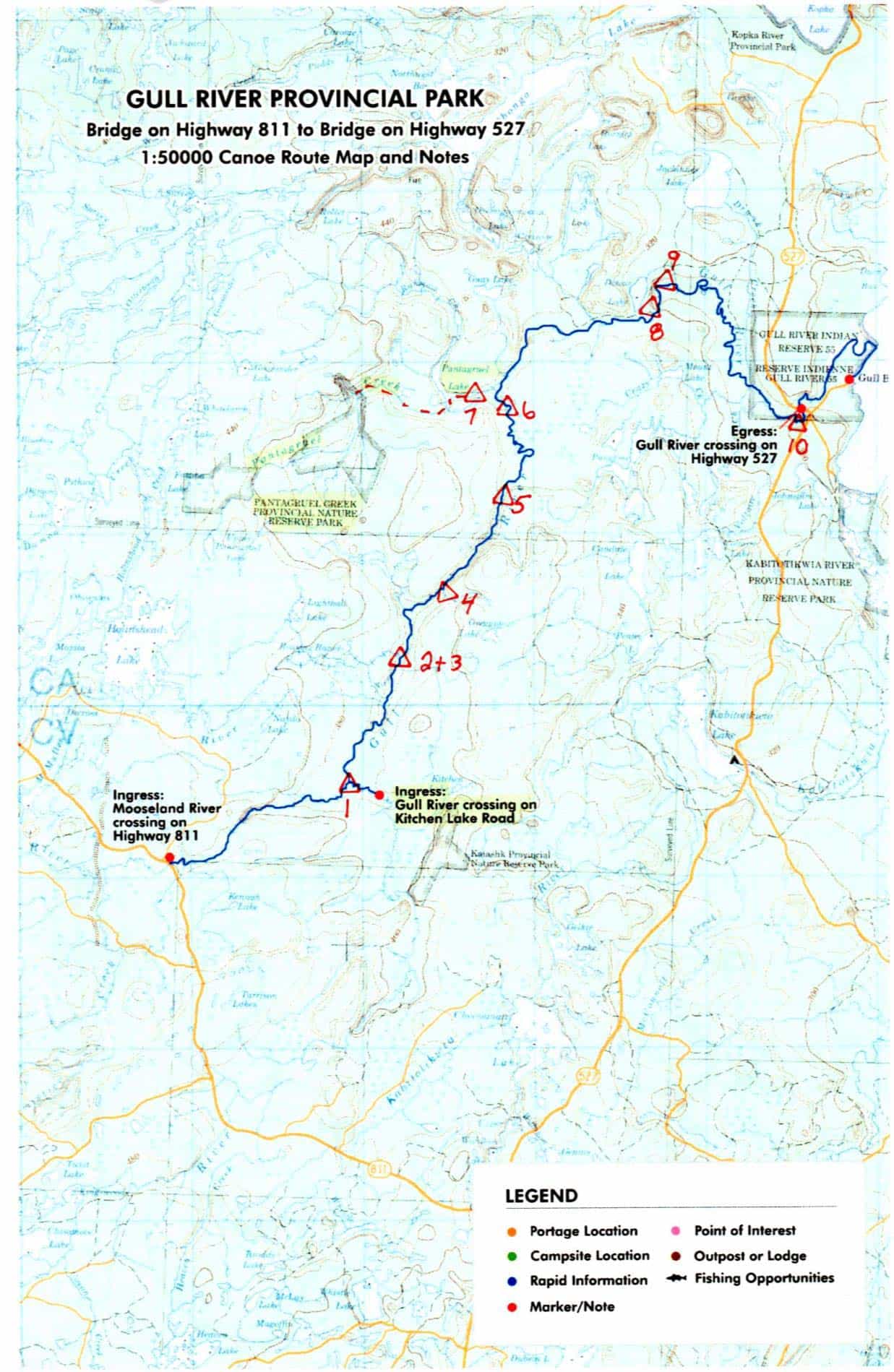
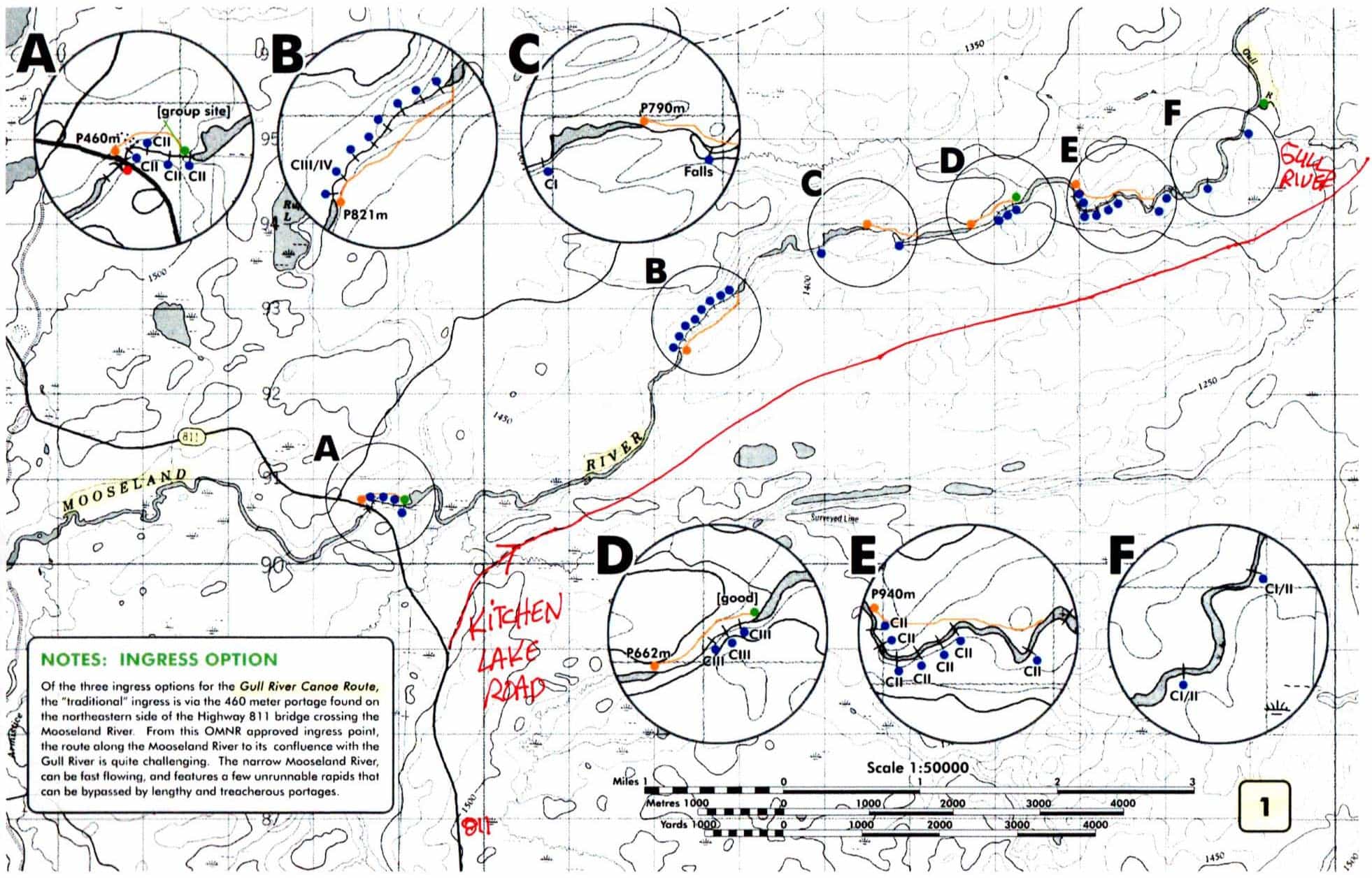
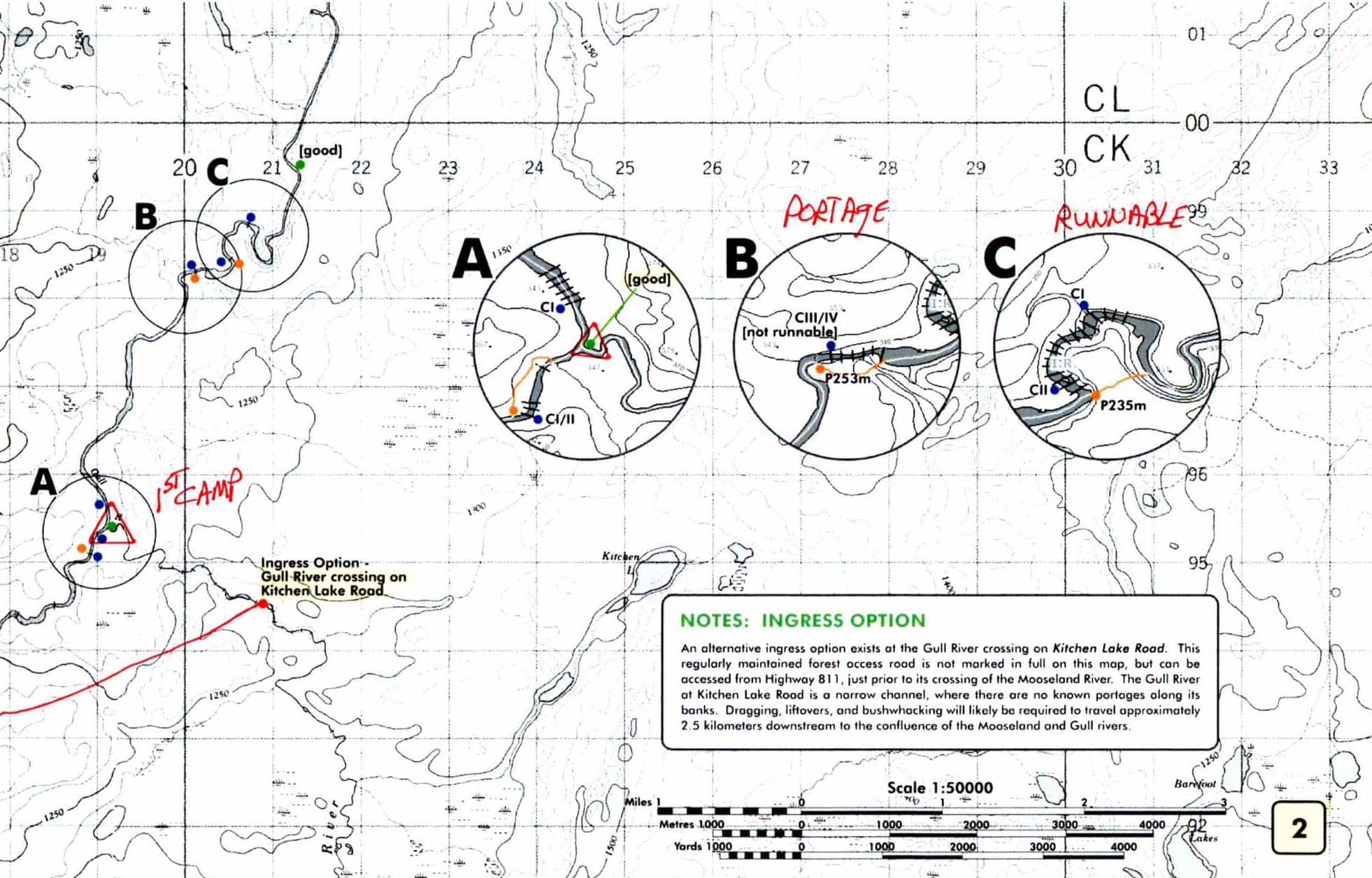
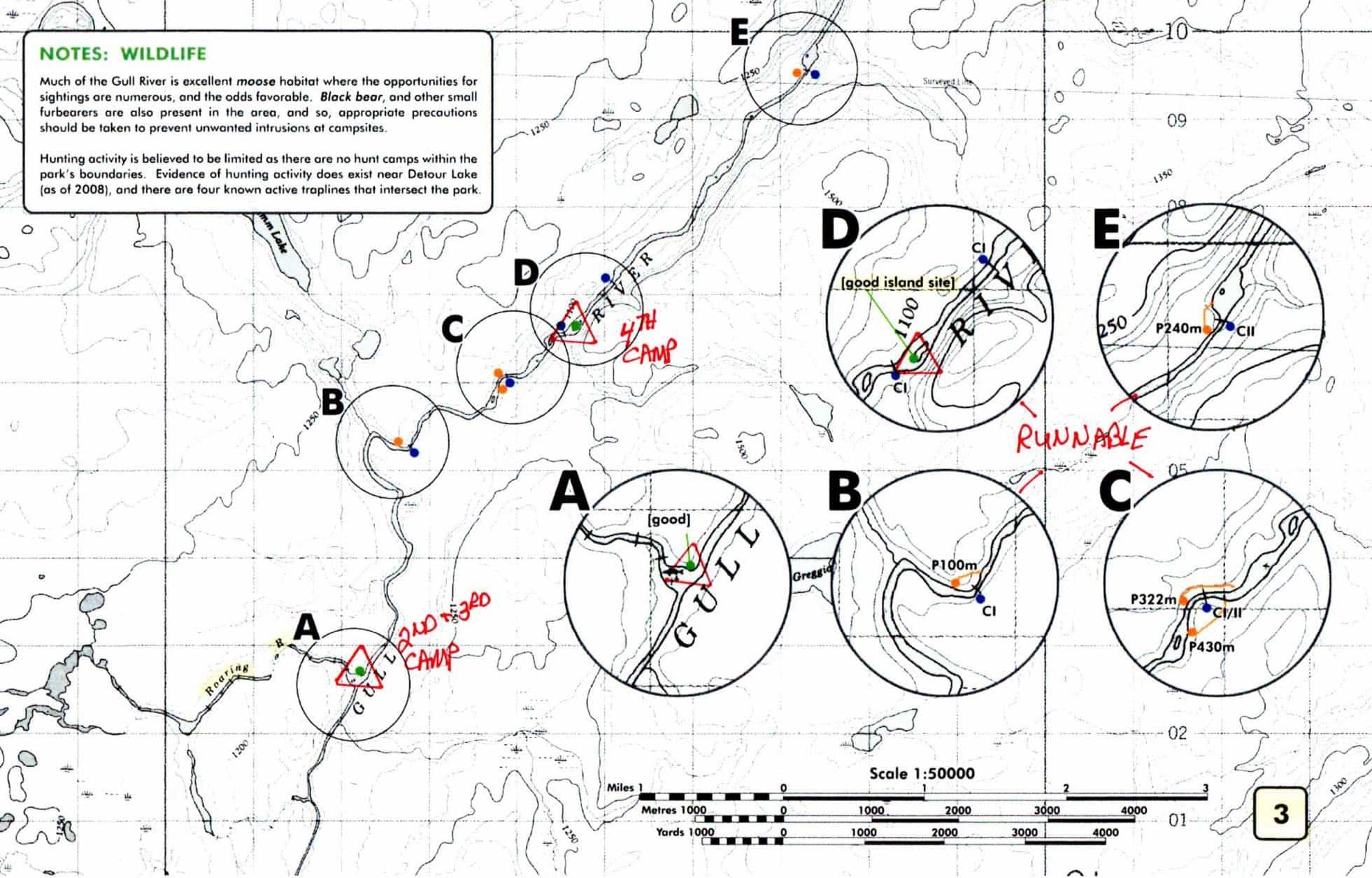
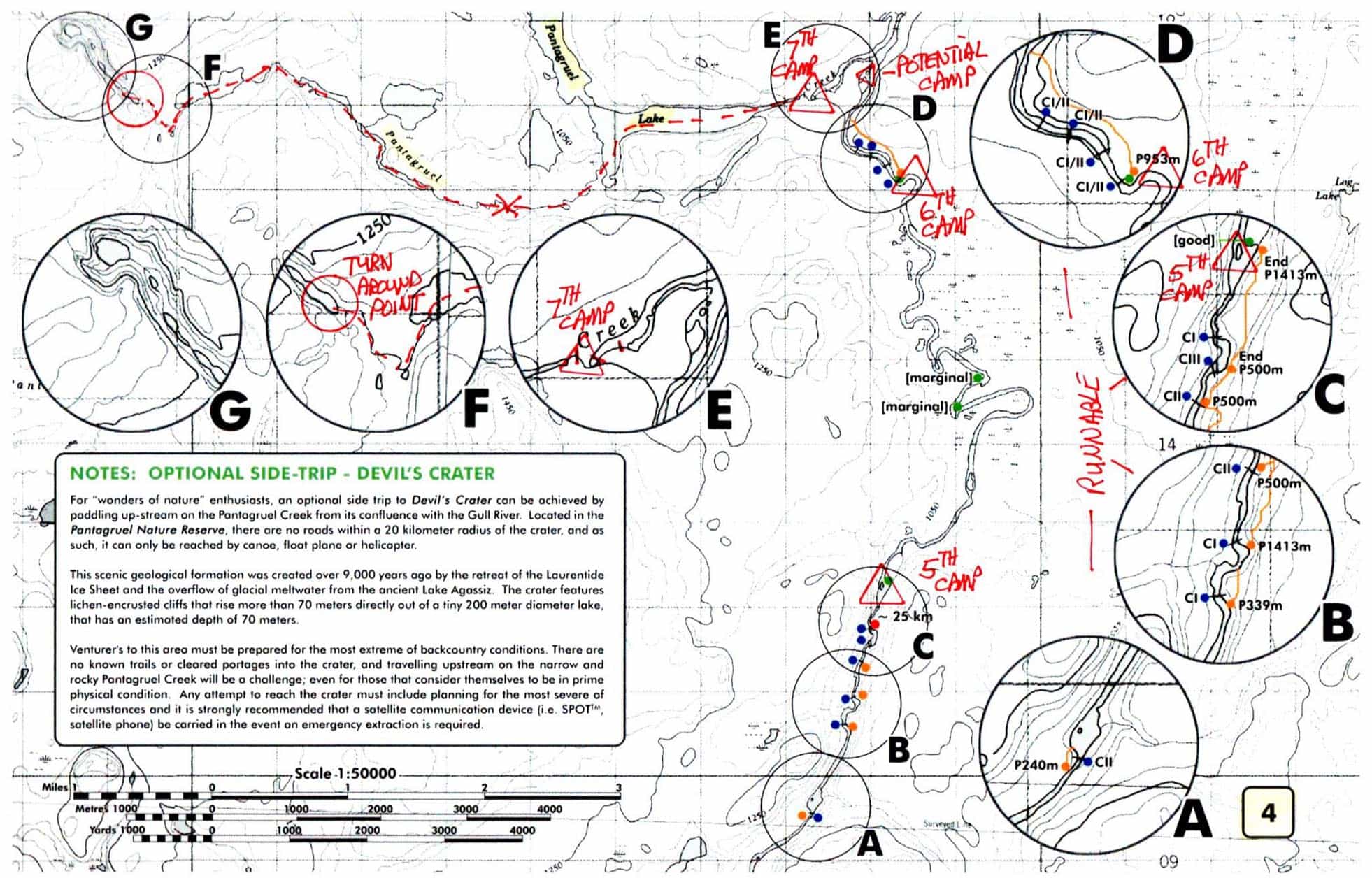
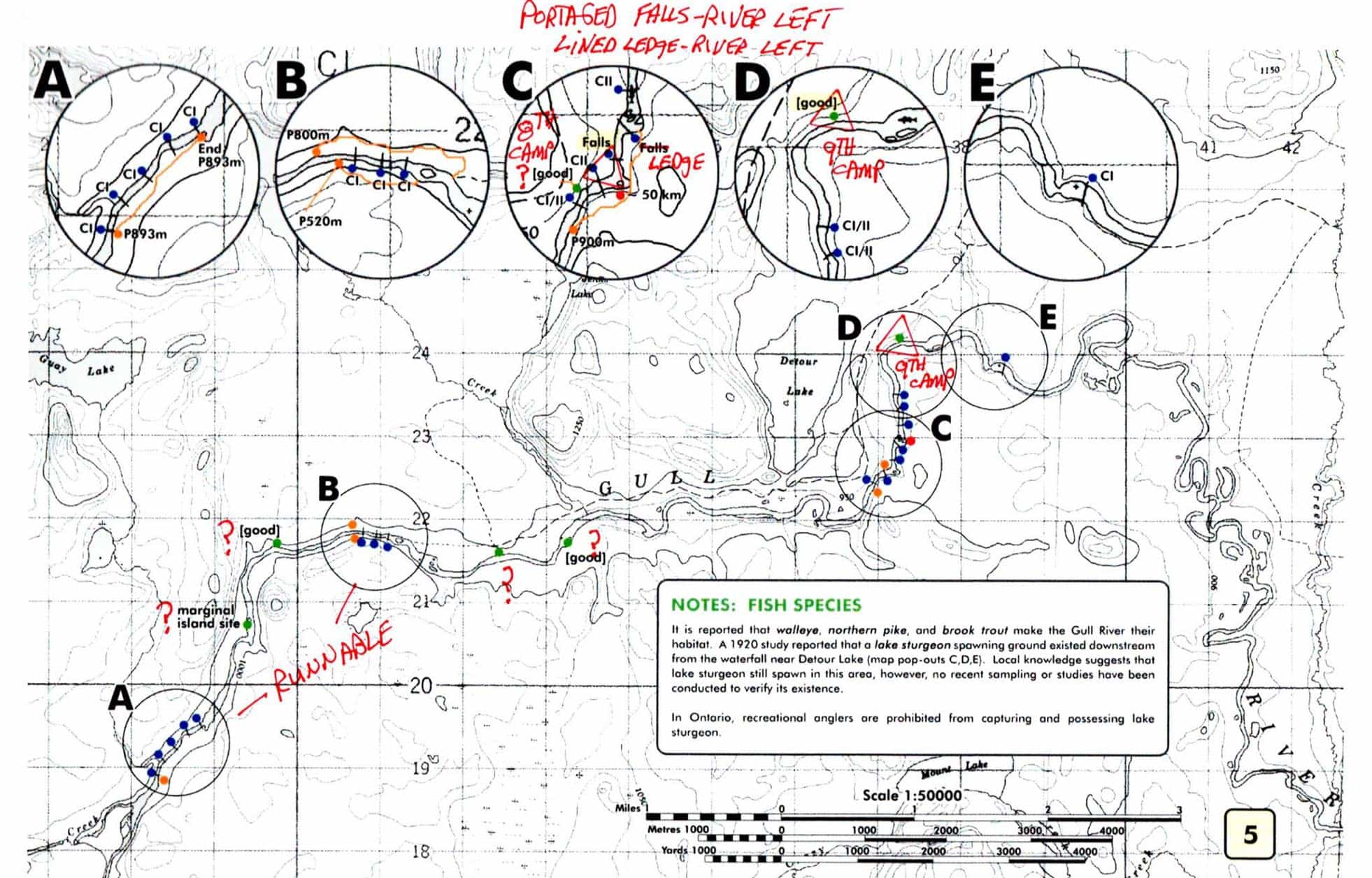
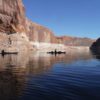
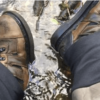






Great trip guide! It brought back fond memories of my trip on the Gull with teenagers in 1987. The story, “Not Hits, Clean Runs No Errors!” is in the 1989 edition of my book CANOEING WILD RIVERS. We began on the Moosland River–it was raining, naturally–and the water was very high. At one long unoccupied campsite (all of them were LONG UNOCCUPIED) we found a shred of newspaper in a bottle that dated (if I recall) 1958. Not a single campsite looked like it had been used in decades. The Ontario trip guide which describes the Gull makes the river look like a piece of cake. It isn’t. The warnings in this trip guide are deadly accurate. To get down it safely requires seriously good judgment and paddling skill.
Cliff Jacobson. Posted Jan. 4, 2017
For clarity, the maps you used and link to, are not provincial maps out of print. These are maps I developed for the paddling community to use as a guide to the river route. And I agree with all, this route is for experienced paddlers and wilderness adventurers.
Ken Kokanie. Posted June 12, 2018
One other note for clarity in portaging past Gull River Falls. On two occasions now, once in 2011 and again in 2015 we have portaged around Gull River Falls on river right, not on left as you note in the log above. The first time we ran the CII above the falls and veered to the right behind an island in a large pool above the falls. From there we marched about 900m in the bush following blazes on trees around the falls and all other rapids. Once at the bottom we noted that below the falls, and in the water conditions we were facing, it was runnable so we marched back and found a way down to the river from the rise on river right that cut the portage in half. In 2015 the water was high and fast, and I wasn’t comfortable even running the CII above the falls, so we portaged in two chunks, once around the CII on river right, then into the pool and to the portage on river right we walked in 2011. This time we did the whole 900m as the entry to the runnable rapids below the falls was too treacherous to do safely.